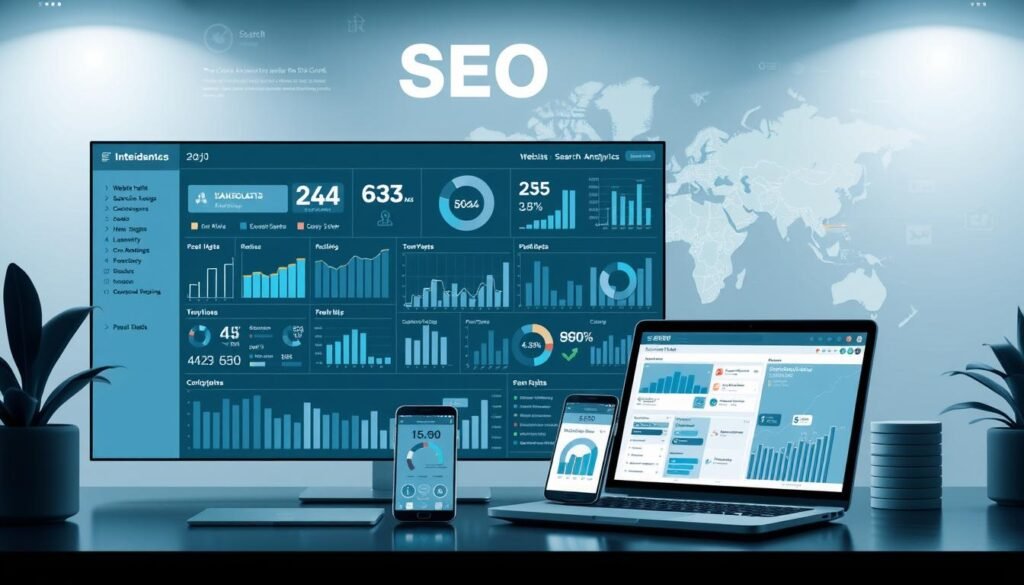In today’s digital landscape, having a website is no longer enough; it needs to be visible and rank high on search engines. A staggering 93% of online experiences begin with a search engine, making it crucial for businesses to optimize their websites for search.
This comprehensive guide will walk you through the fundamentals of search engine optimization, from understanding the basics to implementing advanced strategies. You’ll learn how to conduct keyword research, optimize on-page elements, and build high-quality backlinks to improve your website’s visibility.
By the end of this tutorial, you’ll be equipped with the knowledge to enhance your website’s search engine rankings and drive more traffic to your site.
Key Takeaways
- Understand the importance of SEO for your website’s visibility
- Learn the basics of keyword research and on-page optimization
- Discover strategies for building high-quality backlinks
- Improve your website’s search engine rankings
- Drive more traffic to your website
Understanding SEO: What It Is and Why It Matters
For businesses looking to thrive online, grasping the basics of SEO is not just beneficial—it’s essential. SEO, or Search Engine Optimization, involves various techniques to improve your website’s visibility on search engines like Google, Bing, and Yahoo.
The Basics of Search Engine Optimization
At its core, SEO is about helping search engines understand your content and making your site more visible to users. This involves optimizing your website’s structure, content, and coding to make it more attractive to search engines. Keyword research is a fundamental aspect of SEO, as it helps you identify the terms and phrases your target audience uses to search for products or services like yours.
Understanding how search engines work is also crucial. Search engines use algorithms to rank websites based on relevance, quality, and user experience. By optimizing your website according to these algorithms, you can improve your ranking and drive more traffic to your site.
Key Benefits of SEO for Your Business
The benefits of SEO for businesses are multifaceted. One of the primary advantages is increased visibility. By ranking higher in search engine results, your business becomes more visible to potential customers, leading to more clicks and visits to your website.
SEO also enhances your credibility. Users tend to trust websites that appear on the first page of search results more than those that are buried deeper. This trust can translate into higher conversion rates and customer loyalty.
| SEO Benefit | Description | Impact on Business |
|---|---|---|
| Increased Visibility | Higher rankings in search results | More clicks and visits to your website |
| Enhanced Credibility | Trust from appearing on the first page | Higher conversion rates and customer loyalty |
| Targeted Traffic | Attracting relevant audience through keyword optimization | Better ROI on marketing efforts |
By understanding and implementing SEO techniques, businesses can significantly improve their online presence and attract more targeted traffic. This, in turn, can lead to better ROI on marketing efforts and sustained business growth.
Keyword Research: The Foundation of SEO
Effective keyword research is the backbone of a successful SEO strategy, enabling businesses to connect with their target audience. By understanding what keywords your audience uses, you can tailor your content to meet their needs, thereby improving your website’s visibility on search engines.
Keyword research involves more than just identifying popular search terms; it’s about understanding the intent behind those searches and the competition for those keywords. This foundational element of SEO helps guide the creation of content that resonates with users and stands out in search engine results.
Identifying Target Keywords
To start, you need to identify the keywords that are most relevant to your business or content. This involves brainstorming a list of terms that your target audience might use when searching for information related to your niche.
- Use tools like Google Keyword Planner or Ahrefs to generate a list of potential keywords.
- Consider the search volume and competition for each keyword.
- Analyze the intent behind the searches to ensure your content meets the user’s needs.
Tools for Effective Keyword Research
Several tools can aid in effective keyword research, providing insights into search volume, competition, and related keywords. Some of the most popular tools include:
| Tool | Description | Features |
|---|---|---|
| Google Keyword Planner | A free tool for keyword research and planning | Search volume data, keyword suggestions |
| Ahrefs | A comprehensive SEO toolset including keyword research | Keyword analysis, backlink analysis, content analysis |
| SEMrush | An all-in-one digital marketing tool including keyword research | Competitor analysis, technical SEO audits, keyword strategy |
Analyzing Keyword Competition
Understanding the competition for your target keywords is crucial. High competition keywords may be challenging to rank for, especially if you’re new to SEO. Analyzing the competition involves:
- Identifying the top-ranking pages for your target keywords.
- Assessing the quality and relevance of the content on those pages.
- Determining the backlink profiles of the top-ranking pages.
By following these steps and utilizing the right tools, you can develop a robust keyword research strategy that enhances your SEO efforts and drives more targeted traffic to your website.

On-Page SEO: Enhancing Your Individual Web Pages
Optimizing individual web pages is crucial for improving your website’s search engine rankings. By focusing on key on-page elements, you can significantly enhance your website’s visibility and drive more traffic to your site.
Crafting SEO-Friendly Titles and Meta Descriptions
Crafting SEO-friendly titles and meta descriptions is a fundamental aspect of on-page SEO. Your title tag should be concise, descriptive, and include your primary keyword. For instance, if you’re optimizing for “SEO techniques,” your title could be “Mastering SEO Techniques: A Beginner’s Guide.” Meta descriptions, on the other hand, provide a brief summary of your page’s content and should entice users to click through from search engine results.
When writing meta descriptions, ensure they are compelling and accurately reflect the content of your page. Including your target keywords can also help improve relevance and visibility in search results. Remember, your meta description should be around 155-160 characters to avoid being truncated.
Using Headers Strategically
Headers play a vital role in structuring your content and making it more readable for both users and search engines. By using header tags (H1, H2, H3, etc.) strategically, you can highlight key sections of your content and improve your page’s SEO. Your main title should be an H1 tag, while subheadings can be H2, H3, and so on.
Effective use of headers not only enhances user experience but also helps search engines understand the hierarchy and relevance of your content. Make sure to include your target keywords in some of your headers to reinforce the topic and improve keyword relevance.
Image Optimization for Better Rankings
Image optimization is another critical aspect of on-page SEO. By optimizing your images, you can improve your page’s load times and enhance user engagement. Start by using descriptive file names that include your target keywords. For example, instead of “image1.jpg,” use “seo-techniques-guide.jpg.”
Additionally, make sure to use alt tags that describe the image and include relevant keywords. This not only helps search engines understand the content of your images but also improves accessibility for users with visual impairments.
By implementing these on-page SEO strategies, you can significantly improve your website’s search engine rankings and drive more qualified traffic to your site. Remember, on-page SEO is just one part of a comprehensive SEO strategy that also includes off-page and technical SEO.
Off-Page SEO: Building Your Online Authority
In the realm of SEO, off-page optimization is just as important as on-page techniques, as it helps to establish your website’s credibility and visibility online. Off-page SEO refers to actions taken outside of your website to impact your rankings within search engine results pages (SERPs).
Importance of Backlinks
Backlinks, or incoming links from other websites, are a crucial component of off-page SEO. They signal to search engines that your content is valuable and worthy of citation. The quality of backlinks is more important than quantity; links from authoritative sites carry more weight.
Key characteristics of high-quality backlinks include:
- Relevance: The linking site should be relevant to your niche or industry.
- Authority: Links from high-authority sites are more valuable.
- Diversity: A diverse range of linking sites indicates a natural backlink profile.
Strategies for Earning Quality Links
Earning quality backlinks requires a strategic approach. Here are some effective strategies:
- Create high-quality, linkable content that others will want to reference.
- Participate in guest blogging to build relationships with other websites.
- Leverage broken link building by finding and replacing broken links on other sites with working links to similar content on your site.
For SEO beginners, starting with these strategies can seem daunting, but they are essential for building a strong online presence.
Social Media’s Role in Off-Page SEO
Social media platforms play a significant role in off-page SEO by increasing your content’s visibility and driving traffic to your site. While social media signals are not direct ranking factors, they can contribute to your online authority by generating buzz around your content.
| Platform | Role in Off-Page SEO |
|---|---|
| Content sharing, community building | |
| Real-time engagement, content promotion | |
| Professional networking, content sharing |
By integrating these off-page SEO strategies into your overall SEO plan, you can enhance your website’s online authority and improve your search engine rankings. Remember, off-page SEO is about building your website’s reputation and visibility across the web.

Technical SEO: Ensuring a Smooth User Experience
In the digital landscape, technical SEO plays a crucial role in enhancing your website’s visibility and user experience. It encompasses various elements that work together to ensure your site is both search engine-friendly and provides a seamless experience for your visitors.
What is Technical SEO?
Technical SEO refers to the process of optimizing your website’s infrastructure to help search engines crawl, index, and rank your site more effectively. This includes aspects such as site speed, mobile responsiveness, and XML sitemaps. By focusing on these technical elements, you can significantly improve your website’s overall performance.
Importance of Website Speed
Website speed is a critical factor in both user experience and search engine rankings. A slow-loading website can lead to higher bounce rates and lower engagement. To optimize your site’s speed, consider compressing images, leveraging browser caching, and minimizing HTTP requests. These strategies can help ensure that your website loads quickly and efficiently.
Mobile-Friendliness and Responsiveness
With the majority of internet users accessing websites through mobile devices, having a mobile-friendly and responsive design is no longer optional. It ensures that your website adapts to different screen sizes and devices, providing a consistent and user-friendly experience. Google also prioritizes mobile-friendly websites in its search results, making this aspect of technical SEO particularly important.
By focusing on technical SEO, you can create a solid foundation for your website’s success, enhancing both its visibility in search engines and its usability for your visitors.
Content Creation: Driving Traffic with Valuable Content
In the realm of SEO, content is king, and crafting high-quality, relevant content is essential for attracting and engaging your target audience. Effective content creation not only drives traffic to your website but also enhances your online authority and credibility.
How to Create SEO-Optimized Content
Creating SEO-optimized content involves several key strategies. First, it’s crucial to conduct thorough keyword research to identify relevant terms and phrases your target audience uses. Incorporate these keywords naturally into your content, ensuring it remains readable and valuable.
Using header tags (H1, H2, H3, etc.) is another important aspect of SEO-optimized content. These tags help structure your content, making it easier for search engines to understand and index.
- Use descriptive and concise headings.
- Incorporate target keywords where relevant.
- Ensure a logical structure for your content.
The Importance of Regular Updates
Regularly updating your content is vital for maintaining its relevance and freshness. Search engines favor websites that consistently provide new and updated information, as it indicates the site is active and deserves crawling more frequently.
Consider the following practices for regular updates:
- Review and refresh existing content to keep it relevant.
- Publish new content on a consistent schedule.
- Repurpose old content into new formats, such as turning a blog post into a video.
Utilizing Content Formats: Blogs, Videos, and More
Diversifying your content formats can help you reach a wider audience and cater to different preferences. Blogs, videos, infographics, and podcasts are all effective formats for engaging your target audience.
| Content Format | Benefits | Best For |
|---|---|---|
| Blogs | Improves SEO, establishes authority | Detailed information, tutorials |
| Videos | Engages visually, increases dwell time | Tutorials, product demos, storytelling |
| Infographics | Presents information visually, shareable | Statistics, data visualization, guides |
By incorporating a mix of these content formats, you can create a robust content strategy that appeals to various segments of your audience.

Local SEO: Targeting Your Community
Targeting your local community with SEO can significantly boost your business’s online presence. For businesses that rely on local customers, being visible in local search results is crucial. Local SEO involves optimizing your online presence to attract more business from relevant local searches.
Understanding Local Search Optimization
Local search optimization is about making your business visible in local search results. This involves using location-specific keywords, creating content relevant to your local audience, and ensuring your website is optimized for local search queries. Local SEO is essential for businesses with a physical location or those serving a specific geographic area.
To optimize for local search, you should start by including your business’s name, address, and phone number (NAP) consistently across the web. This information should be on your website and listed in local directories and citations.
Google My Business and Its Benefits
Google My Business (GMB) is a free tool that allows businesses to manage their online presence across Google, including Search and Maps. Claiming and optimizing your GMB listing is one of the most effective local SEO strategies. It helps your business appear in local search results and on Google Maps, making it easier for customers to find you.
To get the most out of GMB, ensure your listing is complete, accurate, and up-to-date. This includes adding high-quality photos, responding to reviews, and posting regular updates. By doing so, you can improve your business’s visibility and attract more local customers.
| Google My Business Feature | Description | Benefit |
|---|---|---|
| Business Profile | Complete and accurate business information | Improved visibility in search results |
| Photos and Videos | Visual content showcasing your business | Enhanced customer engagement |
| Reviews | Customer feedback and ratings | Increased credibility and trust |
Local Citations: What They Are and Why They Matter
Local citations refer to mentions of your business’s NAP on other websites, especially local directories, review sites, and social media platforms. Consistent and accurate citations across the web help search engines understand your business’s identity and location. This can improve your local search rankings and make it easier for customers to find you.
To build local citations, start by listing your business in reputable local directories and ensuring consistency across all listings. You can also leverage social media platforms to create additional citations.
By focusing on local SEO, you can increase your business’s online visibility, attract more local customers, and drive growth. Whether you’re a beginner or looking to refine your SEO strategy, understanding and implementing local SEO best practices is crucial for success.
Measuring SEO Success: Metrics That Matter
To gauge the effectiveness of your SEO efforts, it’s essential to track the right metrics. Understanding how to measure SEO success can make a significant difference in your online strategy.

Understanding Key Performance Indicators (KPIs)
KPIs are quantifiable measures used to evaluate the success of your SEO strategy. Common KPIs include organic traffic, keyword rankings, and conversion rates. By monitoring these indicators, you can identify areas of improvement and adjust your strategy accordingly.
Organic traffic is a crucial KPI, as it reflects the number of visitors reaching your site through search engines. Keyword rankings indicate how well your content is optimized for specific search terms. Meanwhile, conversion rates measure the percentage of visitors who complete a desired action on your site.
Tools for SEO Performance Tracking
Several tools are available to help track SEO performance. Google Analytics is a powerful tool for understanding website traffic and behavior. It provides insights into how users interact with your site, helping you refine your SEO strategy.
- Google Search Console: Helps monitor keyword rankings and identify technical SEO issues.
- Ahrefs: Offers comprehensive backlink analysis and keyword research capabilities.
- SEMrush: Provides technical SEO audits and competitor analysis.
Adjusting Your Strategy Based on Data
Once you’ve gathered data on your SEO performance, it’s crucial to analyze it and make informed decisions. This might involve adjusting your keyword targets, improving site speed, or enhancing content quality.
By regularly reviewing your SEO metrics and adapting your strategy, you can improve your website’s visibility and drive more meaningful traffic. This data-driven approach ensures that your SEO efforts are aligned with your business goals.
Common SEO Mistakes: What to Avoid
Effective SEO requires more than just knowledge; it demands awareness of the pitfalls that can derail your efforts. As you work to optimize your website, understanding the common mistakes that can harm your ranking and visibility is crucial.
Over-Optimization: Finding the Right Balance
One of the most significant SEO mistakes is over-optimization. This occurs when you excessively use keywords, creating content that sounds unnatural or spammy. To avoid this, focus on creating high-quality, engaging content that incorporates your target keywords in a natural way.
For instance, instead of repeating the same keyword multiple times, vary your language by using synonyms or related phrases. This not only improves readability but also helps you rank for a broader range of search queries.
Ignoring Mobile Users
In today’s digital landscape, mobile-friendliness is no longer optional. With the majority of internet users accessing websites through mobile devices, ignoring mobile users can significantly impact your SEO. Ensure your website is responsive and provides a seamless user experience across all devices.
To test your website’s mobile-friendliness, you can use tools like Google’s Mobile-Friendly Test. This tool will identify areas for improvement and provide recommendations for enhancing your mobile user experience.
Neglecting User Experience
User experience (UX) plays a critical role in SEO. Search engines favor websites that provide a positive UX, characterized by fast loading times, easy navigation, and valuable content. Neglecting UX can lead to higher bounce rates and lower search engine rankings.
To improve UX, focus on creating a clear site structure, optimizing images, and ensuring your content is informative and engaging. Regularly gathering feedback from users can also help identify areas for improvement.
By being aware of these common SEO mistakes and taking steps to avoid them, you can improve your website’s visibility, drive more traffic, and achieve your online goals. Remember, SEO is a long-term strategy that requires ongoing effort and optimization.
Keeping Up with SEO Trends and Updates
Staying ahead in the ever-changing world of SEO requires constant vigilance and a willingness to adapt to the latest trends and updates. The landscape of search engine optimization is constantly shifting, with search engines like Google regularly updating their algorithms to improve user experience and combat spam.
The Importance of Staying Informed
Staying informed about the latest SEO trends and updates is crucial for maintaining your website’s visibility and relevance. By keeping up-to-date, you can adjust your SEO strategy to align with the latest best practices, ensuring that your website continues to rank well in search engine results.
Being informed allows you to anticipate and respond to changes in search engine algorithms, reducing the risk of your website being negatively impacted by updates.
Recommended Resources for SEO News
There are several resources available for staying informed about the latest SEO news and trends. Some of the most reliable sources include:
- Industry-leading blogs such as Moz, Ahrefs, and SEMrush
- SEO conferences and webinars
- Social media platforms, where industry experts and professionals share their insights and experiences

Adapting to Search Engine Algorithm Changes
Search engine algorithm changes can have a significant impact on your website’s ranking and visibility. To adapt to these changes, it’s essential to understand the nature of the update and how it affects your SEO strategy.
By monitoring your website’s performance closely and making adjustments as needed, you can minimize the negative impacts of algorithm changes and capitalize on new opportunities.
Regularly reviewing and updating your SEO strategy to align with the latest algorithm changes will help ensure that your website remains competitive and visible in search engine results.
Conclusion: Your SEO Journey Begins Here
Embarking on an SEO journey can seem daunting, but with the right guidance, you can optimize your website for search engines effectively. This comprehensive guide has covered the essential aspects of SEO, from understanding the basics to advanced techniques.
Key Takeaways
We’ve explored the foundation of SEO, including keyword research, on-page optimization, and technical SEO. Understanding these concepts is crucial for improving your website’s visibility and driving more traffic to your site.
Next Steps
Now that you’ve gained a solid understanding of SEO principles, it’s time to put them into practice. Start by conducting keyword research using tools like Google Keyword Planner or Ahrefs, and optimize your website’s meta tags and content accordingly. For those new to SEO, consider this a beginner’s guide to SEO, helping you navigate the initial steps.
Continuing Your SEO Journey
SEO is a constantly evolving field, and staying updated is key to maintaining your website’s search engine rankings. Continue learning with resources like Moz’s SEO tutorials and SEMrush’s guides, perfect for those looking for SEO for beginners content to further their knowledge.
FAQ
What is SEO and why is it important for my website?
How do I conduct keyword research for my SEO strategy?
What are the best practices for on-page SEO?
How do I build high-quality backlinks for off-page SEO?
What is technical SEO and why is it important?
How often should I update my content for SEO?
What is local SEO and how do I optimize for it?
How do I measure the success of my SEO efforts?
What are common SEO mistakes to avoid?
How do I stay up-to-date with the latest SEO trends and updates?
What are some recommended resources for learning more about SEO?
Prabir Dutta
Prabir Dutta is a passionate digital creator, affiliate marketer, and wellness enthusiast who simplifies complex topics like AI tools, Vastu, pet care, and modern living. With a keen eye for SEO, tech trends, and everyday health solutions, he writes to empower readers with actionable, smart-living insights. When not curating content across his network of niche blogs, Prabir enjoys exploring new digital tools that make life easier and more efficient.






